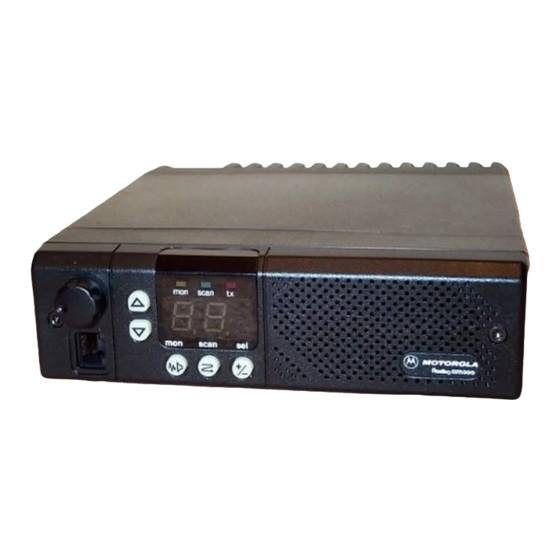Motorola RADIUS GM300 서비스 매뉴얼 - 페이지 34
{카테고리_이름} Motorola RADIUS GM300에 대한 서비스 매뉴얼을 온라인으로 검색하거나 PDF를 다운로드하세요. Motorola RADIUS GM300 49 페이지. 16-channel, conventional fm radio
Motorola RADIUS GM300에 대해서도 마찬가지입니다: 서비스 매뉴얼 (28 페이지), 사용 설명서 (18 페이지), 사용 설명서 (19 페이지), 사용자 설명서 (37 페이지), 운영 지침 (2 페이지)

Name of Manual
Data Path
Receiver audio is also used for decoding of signaling
tones or codes. There are two general classiÞcations of
the types of data involved. High-speed data refers to
data which occupies the voice range of frequencies
(between 300 and 3000 Hz, although it can also occupy
the entire range from less than 1 Hz to 3000 Hz). This
data is not transmitted simultaneously with voice. The
other type is low-speed data, which is contained to fre-
quencies below 300 Hz, generally at reduced deviation
levels, and may be transmitted simultaneously with
voice. MDC1200 and Select 5 are examples of high-
speed data; PL and DPL are examples of low- speed
data.
Low speed data is obtained from U551B-7, which con-
tains frequencies between 0.6 Hz and 3000 Hz. It is
buffered by U602A and Þltered by U603A and U603B
in masked logic boards, or U602B and U603A in
expanded logic boards. These form a 5-pole biqua-
dratic low pass Þlter, attenuating all signals above
250 Hz. This Þlter prevents voice from interfering with
low-speed data detection. This is fed to a center-slicer
(U601B in masked, U603B in expanded) which con-
verts the tone or data into a symmetrical square wave
which can be decoded by the microcomputer. The cen-
ter slicer tracks out near-DC offsets to maintain wave-
form symmetry. In expanded boards, U603B is an
opamp rather than a comparator, and transistor Q601
is used to provide level shifting to a 0-to-5V logic level.
High speed data can be obtained from either U551B-7,
the same point as for low-speed data, or from U552B-7,
which only contains frequencies between 300 and 3000
Hz. If the type of data does not contain information
below 300 Hz, the use of additional 300 Hz high-pass
Þltering improves detector sensitivity. No additional
Þltering is required, only that the signal is squared up
by center-slicer U601A before being applied to the
microcomputer for decoding.
Transmitter Audio
Voice Path
Microphone audio is routed from the front panel mic
jack via J8- 14, or from accessory connector J3-2, to the
mic mute gate Q651. DC bias is applied to operate the
transistor ampliÞer within the micro-phone. Q651 is
controlled by Q652 and mutes the microphone audio
path during receive mode or during transmission of
high- speed signaling or data. When low mic gain (80
mV rms for 60% deviation) is selected by JU651, the
signal is pre-emphasized by C652 and R655; for high-
gain (40 mV rms), by C667 and R647. Supply rail limit-
ing by U651A prevents over-deviation.
The signal is then routed to the RF board reference
oscillator modulation input via J6-13, and, via buffer
U652A, to voltage controlled attenuator U652. Devia-
March, 1997
tion is adjusted by programming the DC output volt-
age of D/A converter U801-6. This allows electronic
adjustment of deviation, compensation for sensitivity
variations across the operating frequency band, and
choice of full system voice deviation on non-PL or DPL
channels, or reduced voice deviation on channels with
PL or DPL. The output of attenuator U653 is routed
through U652B, a 3-pole biquadratic 3000 Hz low-pass
ÒsplatterÓ Þlter, before being applied to the RF board as
VCO modulation via J6-10.
Radios used in 12.5 kHz channel spacing systems
require full deviation of 2.5 kHz, instead of 5 kHz for
25/30 kHz systems. This reduction is accomplished by
resistor values on the RF board surrounding the VCO
MOD and REF MOD adjust posts.
Data Path
High speed data is generated by microcomputer out-
puts U802-30 and 31 which are summed by opamp
U602B (masked) or U701A (expanded). The ratio of
R701 and R702, and the relative timing of the transi-
tions of the two microcomputer outputs, allow low-
distortion simulated sinewaves to be generated. The
opamp output is routed to the input of limiter U651A,
where it is summed with pre-emphasized mic audio.
The audio path from U651A to the limiter is not pre-
emphasized. The remainder of the audio path to the
modulator is the same as for the voice signal path.
In masked logic boards, audio applied to accessory
connector J3-5 is applied, without pre-emphasis, to the
input of the limiter U651A. In expanded logic boards,
jumper JU701 allows either this path to be chosen
(position ÒAÓ), or allows J3-5 audio to be routed via
low-speed data Þlter U701B (JU701 in position ÒBÓ)
and introduced into the transmitter audio path after
the limiter. In this conÞguration, externally-generated
PL may be applied to the transmitter without being
ÒcapturedÓ (attenuated or removed entirely) when lim-
iting due to voice peaks occurs.
Low speed data is generated by microcomputer out-
puts U802-27 and 28 which are summed by opamp
U651B (masked) or U701B (expanded). The ratio of
R706 and R707 allow low-distortion simulated sine-
waves to be generated. The opamp is conÞgured as a 3-
pole biquadratic low pass Þlter to remove any distor-
tion components of the low speed data signal above
300 Hz which would fall within the voice range. This
audio is resistively summed with the output of the lim-
iter U651A. In this manner, limiting on voice peaks will
not affect the continuous low speed data transmission.
The summed audio is then routed to the REF MOD
input of the RF board via J6-13, and to the voltage con-
trolled attenuator, splatter Þlter, and VCO MOD input
of the RF board (J6-10), following the same path as
voice signals.
68 No.
Theory of Operation
Logic Board
2-9
